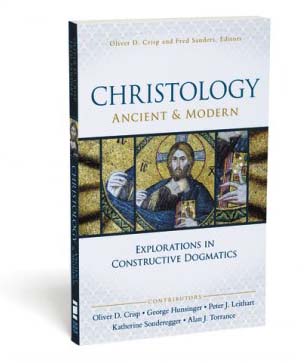 Christology Ancient & Modern: Explorations in Constructive Dogmatics is the first volume in a series of books that will make the proceedings of the annual Los Angeles Theology Conference available to a wider audience. Only a lucky few hundred people were at the annual conference in January 2013, but this 200-page paperback from Zondervan collects all of the plenary papers and more than half of the parallel-session papers.
Christology Ancient & Modern: Explorations in Constructive Dogmatics is the first volume in a series of books that will make the proceedings of the annual Los Angeles Theology Conference available to a wider audience. Only a lucky few hundred people were at the annual conference in January 2013, but this 200-page paperback from Zondervan collects all of the plenary papers and more than half of the parallel-session papers.
Oliver Crisp and I are the series editors, and together with the team at Zondervan (above all Katya Covrett), we got this baby into print in nine months.
I had a real rush of excitement when I got my copy of the book. As I flipped through the ten chapters, I kept finding myself saying, “hey, this is a really good essay… and so is this… and this.” I should have known they were good, because I helped commission them, select them, edit them into manuscript form, and proofread the final pages. But there’s just something magic about the actual book showing up, and this volume is (if I do say so myself) a really solid piece of work.
The ten chapters are:
Oliver Crisp, “Desiderata for Models of the Hypostatic Union.” Remarkably nimble, this chapter surveys the fundamental decisions to be made in christology, explains how the various doctrinal topics impinge on each other, and describes what Chalcedonian christologies ought to be committed to. Prolegomena to any future christology?
George Hunsinger, “Salvator Mundi: Three Types of Christology.” High and low christology are helpful categories, but Hunsinger sheds much more light on the subject by adding a middle category. Hunsinger excels at showing how these various christologies harmonize with their corresponding accounts of salvation.
Katherine Sonderegger, “The Humility of the Son of God.” Possibly the most unique and creative essay in christology that I’ve seen in years, this project makes use the transcendentals to develop an account of Christ’s full deity and his incarnation.
Scott Swain and Michael Allen, “The Obedience of the Eternal Son.” Swain and Allen take up a particularly knotty problem in modern christology and place it into dialogue with the great tradition of christological and trinitarian doctrine. All roads lead to the eternal generation of the Son.
Jeremy Treat, “Exaltation in and Through Humiliation.” It’s too simplistic to think of Christ’s lowliness and exaltedness as two successive stages of ministry. Treat analyzes kingship and the cross to show how the so-called states of Christ overlap and inform each other.
Peter Leithart, “We Saw His Glory: Implications of the Sanctuary Christology in John’s Gospel.” Actually an exercise in a typological variety of the theological interpretation of Scripture, this Leithart essay develops a biblical motif that has been neglected by systematic theology.
Jason McMartin, “The Theandric Union as Imago Dei and Capax Dei.” McMartin argues that the image of God is the capacity for relationship with God, and shows how this is relevant (in different ways) for anthropology as well as christology.
Jordan Wessling, “Christology and Conciliar Authority: On the Viability of Monotheletism for Protestant Theology.” Wessling considers the claims of recent advocates of a “one-will” christology, weighing these claims both on their own merit as well as on their tensions with the well-established “two-wills” tradition.
Telford Work, “Jesus’ New Relationship with the Holy Spirit, and Ours: How Biblical Spirit-Christology Helps Resolve a Chalcedonian Dilemma.” Work brings in the notion of “concurrence of relations” to do some of the work that has previously been assigned to “communication of attributes,” in order to nest christology more securely in a trinitarian framework.
Alan Torrance, “Reclaiming the Continuing Priesthood of Christ: Implications and Challenges.” Moving back and forth from biblical to systematic reflections, Torrance urges an “inclusive, Trinitarian vision of sharing (Hebrews), participating (Paul), abiding (John) by the Spirit, in Christ.”
We had to leave out some excellent papers, and the actual conference included a great deal of ongoing conversation in the Q&A periods, at the book tables, over meals, and at a closing panel discussion. For the panel discussion, you can watch the video as well as all the plenary talks at the conference website. But this 200-page volume captures the main topics and the most definitive essays from the inaugural year of the Los Angeles Theology Conference.